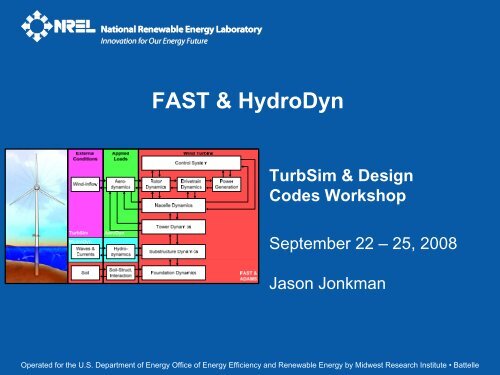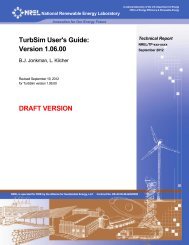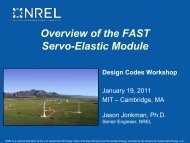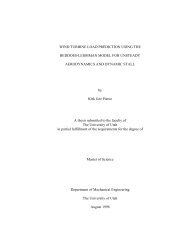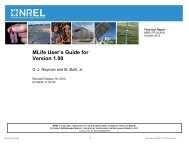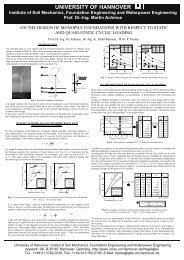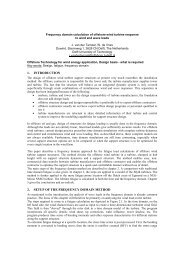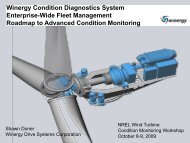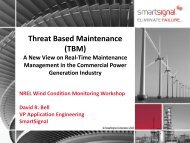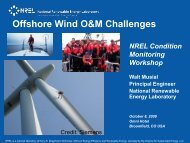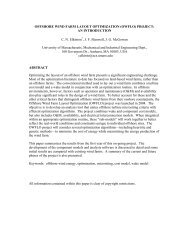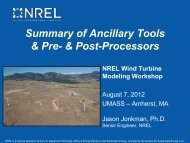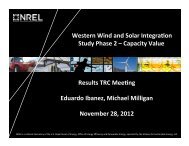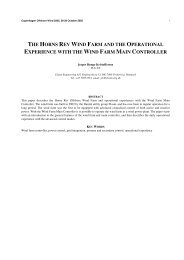FAST & HydroDyn - NREL
FAST & HydroDyn - NREL
FAST & HydroDyn - NREL
You also want an ePaper? Increase the reach of your titles
YUMPU automatically turns print PDFs into web optimized ePapers that Google loves.
<strong>FAST</strong> & <strong>HydroDyn</strong><br />
TurbSim & Design<br />
Codes Workshop<br />
September 22 – 25, 2008<br />
Jason Jonkman<br />
Operated for the U.S. Department of Energy Office of Energy Efficiency and Renewable Energy by Midwest Research Institute • Battelle
Outline<br />
• <strong>FAST</strong> Overview:<br />
– Background<br />
– Basic Theory<br />
– Degrees of Freedom<br />
– Analysis Modes:<br />
• Simulation<br />
• Linearization<br />
• <strong>HydroDyn</strong> Overview:<br />
– Monopiles<br />
– Floating Platforms<br />
• Current & Planned Work<br />
• Future Opportunities<br />
National Renewable Energy Laboratory 2 Innovation for Our Energy Future
<strong>FAST</strong> Overview<br />
What Is It<br />
• Structural-dynamic model for horizontal-axis wind turbines:<br />
– Stands for Fatigue, Aerodynamics, Structures, & Turbulence<br />
– Coupled to AeroDyn & <strong>HydroDyn</strong> & controller for aero-hydro-servoelastic<br />
simulation<br />
– Evaluated by Germanischer Lloyd WindEnergie<br />
• Current version:<br />
– Official (land-based): v6.01 (August 2005)<br />
– Unofficial (includes <strong>HydroDyn</strong>): v6.10a-jmj (February 2007)<br />
• User’s Guide:<br />
– Jonkman & Buhl (2005)<br />
• Theory Manual (unofficial):<br />
– Jonkman (2005)<br />
National Renewable Energy Laboratory 3 Innovation for Our Energy Future
<strong>FAST</strong> Overview<br />
History<br />
<strong>FAST</strong>2, <strong>FAST</strong>3 (pre-1996)<br />
• Developer: B. Wilson, OSU<br />
• Different code for 2- & 3-blades<br />
• Built-in aerodynamics<br />
<strong>FAST</strong>_AD2, <strong>FAST</strong>_AD3 (1996)<br />
• Developer: A. Wright, <strong>NREL</strong><br />
• Different code for 2- & 3-blades<br />
• AeroDyn aerodynamics<br />
<strong>FAST</strong> v4 – v6 (2002-present)<br />
• Developer: J. Jonkman, <strong>NREL</strong><br />
• Single code for 2- & 3-blades<br />
• Rederived & implemented EoM<br />
• New DOFs (furling, platform)<br />
• AeroDyn aerodynamics<br />
• <strong>HydroDyn</strong> hydrodynamics<br />
• Linearization<br />
• <strong>FAST</strong>-to-ADAMS preprocessor<br />
<strong>FAST</strong>_AD v1 – v3 (1997-2002)<br />
• Developers: N. Weaver, M. Buhl,<br />
et al., <strong>NREL</strong><br />
• Single code for 2- & 3-blades<br />
• AeroDyn aerodynamics<br />
National Renewable Energy Laboratory 4 Innovation for Our Energy Future
<strong>FAST</strong> Overview<br />
Turbine Configurations<br />
• Horizontal-axis (HAWT)<br />
• 2- or 3-bladed rotor<br />
• Upwind or downwind rotor<br />
• Rigid or teetering hub<br />
• Conventional configuration or<br />
inclusion of rotor- &/or tailfurling<br />
• Land- or sea-based<br />
• Offshore monopiles or floating<br />
• Rigid or flexible foundation<br />
National Renewable Energy Laboratory 5 Innovation for Our Energy Future
National Renewable Energy Laboratory 6 Innovation for Our Energy Future<br />
<strong>FAST</strong> Overview<br />
Basic Theory<br />
(any questions)
<strong>FAST</strong> Overview<br />
Basic Theory (cont)<br />
• Combined modal & multi-body dynamics formulation:<br />
– Modal: blades, tower<br />
– Multi-body: support platform, base plate, nacelle, generator, gears,<br />
hub, tail<br />
• Mode shapes specified as 6 th order polynomials<br />
• Utilizes relative DOFs:<br />
– No constraint equations<br />
– ODEs instead of DAEs<br />
• Equations of motion (EoMs) are derived & implemented using<br />
Kane’s Method<br />
• EoM Form:<br />
( ) ( <br />
d )<br />
M q,u,t q + f q,q,u,u ,t = 0<br />
• Uses the 4 th order Adams-Bashforth-Adams-Moulton (ABAM)<br />
predictor-corrector fixed-step-size integration scheme:<br />
– Initialized using 4 th order Runge-Kutta scheme<br />
National Renewable Energy Laboratory 7 Innovation for Our Energy Future
<strong>FAST</strong> Overview<br />
Basic Theory (cont)<br />
• Blade & tower beam mode assumptions:<br />
– Bernoulli-Euler beams with bending:<br />
• No axial or torsional DOFs<br />
• No shear deformation<br />
– Linear modal representation considers small to moderate<br />
deflections characterized by lowest modes:<br />
• Employs small angle approximations with correction for<br />
orthogonality<br />
• Includes 2 nd order correction for radial shortening<br />
– Beams are straight with isotropic material & no mass or<br />
elastic offsets:<br />
• Couplings only due to pretwist (blades only)<br />
• Other assumptions:<br />
– Support platform pitch, roll, & yaw rotations employ small<br />
angle approximations with correction for orthogonality<br />
• All other DOFs may exhibit large displacements<br />
w/o loss of accuracy<br />
1 st mode<br />
2 nd mode<br />
Modal<br />
Representation<br />
National Renewable Energy Laboratory 8 Innovation for Our Energy Future
National Renewable Energy Laboratory 9 Innovation for Our Energy Future<br />
<strong>FAST</strong> Overview<br />
Degrees of Freedom<br />
Blades: 2 flap modes per blade<br />
1 edge mode per blade<br />
Tower: 2 fore-aft modes<br />
2 side-to-side modes<br />
Drivetrain: 1 generator azimuth<br />
1 shaft torsion<br />
Nacelle: 1 yaw bearing<br />
Teeter: 1 rotor teeter hinge with<br />
optional δ 3 (2-blader only)<br />
Furl: 1 rotor-furl hinge of arbitrary<br />
orientation & location between<br />
the nacelle & rotor<br />
1 tail-furl hinge of arbitrary<br />
orientation & location between<br />
the nacelle & tail<br />
Platform: 3 translation (surge, sway, heave)<br />
3 rotation (roll, pitch, yaw)<br />
Total:<br />
24 DOFs available for 3-blader<br />
22 DOFs available for 2-blader
National Renewable Energy Laboratory 10 Innovation for Our Energy Future<br />
<strong>FAST</strong> Overview<br />
Furling DOFs<br />
Rotor-furl<br />
axis<br />
Rotor-furl<br />
Yaw bearing<br />
C.M.<br />
Arbitrary point on<br />
tail-furl axis<br />
Tail-furl<br />
axis<br />
Tail-furl<br />
z n<br />
y n<br />
x n<br />
Wind<br />
Arbitrary point on<br />
rotor-furl axis<br />
Layout of a 3-Bladed, Upwind, Furling Turbine: Furl Axes
<strong>FAST</strong> Overview<br />
Modes of Operation<br />
National Renewable Energy Laboratory 11 Innovation for Our Energy Future
National Renewable Energy Laboratory 12 Innovation for Our Energy Future<br />
<strong>FAST</strong> Overview<br />
Simulation<br />
• Nonlinear time-domain solution for loads analysis<br />
• Run simulation within command prompt (.exe) or within<br />
MATLAB/Simulink (.mex*)<br />
• Design situations<br />
& conditions:<br />
– Turbulent &<br />
deterministic winds<br />
– Regular & irregular<br />
waves<br />
– Power production<br />
with control<br />
– Start-ups & shut-down<br />
maneuvers<br />
– Idling & parked<br />
conditions<br />
– Control system faults<br />
Design Situation DLC Wind<br />
Condition<br />
Power production 1.x<br />
Power production plus 2.x<br />
occurrence of fault<br />
Start up 3.x<br />
Normal shut down 4.x<br />
Emergency shut down 5.x<br />
Parked 6.x<br />
Parked with fault 7.x<br />
Transport, assembly,<br />
and maintenance<br />
8.x<br />
Wave<br />
Condition<br />
Load Case Matrix<br />
Directionality<br />
Other<br />
Conditions<br />
Type of<br />
Analysis
National Renewable Energy Laboratory 13 Innovation for Our Energy Future<br />
<strong>FAST</strong> Overview<br />
Simulation – Inputs & Outputs (I/O)<br />
• IEC-style coordinate systems for I/O<br />
• Inputs parameters:<br />
– Simulation control:<br />
• Total time, time step<br />
– Feature flags<br />
– Initial conditions<br />
– Turbine configuration:<br />
• Geometry<br />
– Mass/inertia<br />
– Distributed blade/tower<br />
mass/stiffness<br />
– Blade/tower mode shapes<br />
– Control settings<br />
– Teeter, yaw, & furl<br />
springs/dampers<br />
– Output parameters<br />
• Outputs parameters:<br />
– Motions:<br />
• Deflections<br />
• Velocities<br />
• Accelerations<br />
• Translational & rotational<br />
– Loads:<br />
• Shear forces<br />
• Axial forces<br />
• Bending moments<br />
• Torsion moments<br />
– Performance:<br />
• Wind<br />
• Power<br />
• Control settings
National Renewable Energy Laboratory 14 Innovation for Our Energy Future<br />
<strong>FAST</strong> Overview<br />
Simulation – Control Options<br />
• Active control:<br />
– Blade pitch:<br />
• Collective or independent<br />
• Command the angle<br />
• No actuator dynamics<br />
– Nacelle yaw:<br />
• Command the angle &/or rate<br />
• Optional 2 nd order actuator<br />
dynamics<br />
– Generator torque:<br />
• Fixed (with or without slip) or<br />
variable speed<br />
• Command the torque<br />
– High-speed shaft brake:<br />
• Command the deployment<br />
– Blade tip brake:<br />
• Command the deployment<br />
• Passive control:<br />
– Rotor teeter:<br />
• Optional damping & soft &<br />
hard stops<br />
– Nacelle yaw:<br />
• Free or restrained<br />
– Rotor furl:<br />
• Optional independent up- &<br />
down- springs & dampers<br />
– Tail furl:<br />
• Optional independent up- &<br />
down- springs & dampers
<strong>FAST</strong> Overview<br />
Simulation – Interfacing Active Controllers<br />
• Fortran subroutine:<br />
– Separate routines for each controller:<br />
• I.e.: Separate routines for pitch, torque, & yaw<br />
– Samples routines provided with <strong>FAST</strong> archive<br />
– Requires recompile with each change to controller<br />
• BLADED-style dynamic link library (DLL):<br />
– DLL interface routines included with <strong>FAST</strong> archive<br />
– Requires recompile of <strong>FAST</strong> (with interface routines) only once<br />
– DLL compiled separately from <strong>FAST</strong>:<br />
• Can be Fortran, C++, etc.<br />
– DLL is a master controller:<br />
• I.e.: Pitch, torque, & yaw controlled with same DLL<br />
• MATLAB/Simulink:<br />
– <strong>FAST</strong> implemented as S-Function block<br />
– Same input files used<br />
– Controls implemented in block-diagram form<br />
National Renewable Energy Laboratory 15 Innovation for Our Energy Future
<strong>FAST</strong> Overview<br />
Simulation – Interfacing Controllers (cont)<br />
<strong>FAST</strong> Wind Turbine Block<br />
Open Loop Simulink Model<br />
National Renewable Energy Laboratory 16 Innovation for Our Energy Future
<strong>FAST</strong> Overview<br />
Modes of Operation<br />
National Renewable Energy Laboratory 17 Innovation for Our Energy Future
<strong>FAST</strong> Overview<br />
Linearization<br />
• Creates linear representation of nonlinear system model<br />
• Applications:<br />
– Full-system modal analysis:<br />
• Frequencies<br />
• Damping<br />
• Mode shapes<br />
– Controls design:<br />
• Develop state-space representation of wind turbine “plant”<br />
• Includes control inputs, wind disturbances, & output<br />
– Stability analysis<br />
• Linear model is only valid in the local vicinity of an operating point (op):<br />
– Requires that one select or compute an op before linearization<br />
• When rotor is spinning, the linear system is periodic:<br />
– Azimuth-averaging averages-out the periodic effects<br />
– Multi-blade coordinate (MBC) expresses cumulative effect of blade dynamics in<br />
the fixed frame<br />
National Renewable Energy Laboratory 18 Innovation for Our Energy Future
<strong>FAST</strong> Overview<br />
Linearization – Calculating Operating Points<br />
• Operating point choices:<br />
– Initial condition (user-selected)<br />
– Static equilibrium (parked or idling)<br />
– Periodic steady-state equilibrium:<br />
• No trim: All controls fixed<br />
• Trim: One control input varied to achieve desired rotor speed:<br />
– Nacelle yaw<br />
– Generator torque<br />
– Blade pitch<br />
• Equilibrium solutions found through time-domain simulation:<br />
– Solution found within user-selected displacement & velocity tolerances<br />
– Solution can be sped up with optional compile-time feature to artificially<br />
increase system damping<br />
– Optional trim calculation is automated with a proportional feedback<br />
control law on rotor-speed error<br />
National Renewable Energy Laboratory 19 Innovation for Our Energy Future
<strong>FAST</strong> Overview<br />
Linearization – Model Linearization (cont)<br />
Nonlinear <strong>FAST</strong> EoM:<br />
( ) ( <br />
d )<br />
M q,u,t q + f q,q,u,u ,t = 0<br />
Perturbation of system variables:<br />
q = q + Δq<br />
op<br />
op<br />
q = q + Δq<br />
op<br />
u = u + Δu<br />
ud = udop + Δud<br />
q = q + Δq<br />
op<br />
Numerical linearization:<br />
f<br />
⎧⎪<br />
Δq⎫⎪<br />
⎧⎪<br />
Δq<br />
⎫⎪<br />
M = M op C = ∂ ⎡∂M<br />
∂ f ⎤<br />
⎡ 0 I ⎤<br />
K = ⎢ q<br />
+ ⎥ x = ⎨ ⎬<br />
⎪⎩Δ<br />
q x<br />
= ⎨ ⎬ A = ∂ q ∂q<br />
∂q<br />
⎪⎭<br />
⎪⎩Δ<br />
q<br />
⎢ −1 −1<br />
⎪⎭<br />
M K M C ⎥<br />
op<br />
⎢⎣<br />
⎥<br />
⎣−<br />
− ⎦<br />
⎦ op<br />
⎡∂M<br />
∂ f ⎤<br />
∂ f<br />
⎡ 0 ⎤ ⎡ 0 ⎤<br />
F =− ⎢ q<br />
+ ⎥ Fd<br />
=− B = ⎢ −1<br />
⎣ ∂u<br />
∂u<br />
⎦<br />
∂ u<br />
M F ⎥ Bd = ⎢ −1<br />
d ⎣ ⎦ M F ⎥<br />
⎣ d ⎦<br />
op<br />
op<br />
2 nd order model:<br />
1 st order model:<br />
M Δq<br />
+ CΔq<br />
+ KΔq= FΔu+<br />
F Δu<br />
y = VelCΔq<br />
+ DspCΔq + DΔu + D Δu<br />
d<br />
d<br />
d<br />
d<br />
x<br />
= Ax + BΔu + B Δu<br />
y = Cx+ DΔu+<br />
D Δu<br />
(matrix sizes determined by enabled DOFs)<br />
National Renewable Energy Laboratory 20 Innovation for Our Energy Future<br />
d<br />
d<br />
d<br />
d
National Renewable Energy Laboratory 21 Innovation for Our Energy Future<br />
<strong>FAST</strong> Overview<br />
Linearization – Model Linearization (cont)<br />
• Linearization done numerically with central-difference method:<br />
– Perturbations made about op<br />
– Perturbations are hard-coded:<br />
• Default: Δq = 2º<br />
• Can be changed at compile time<br />
−M<br />
−1<br />
C<br />
≈<br />
( + Δ ) − ( −Δ<br />
)<br />
q q q q q q<br />
op<br />
2Δq<br />
op<br />
−M<br />
−1<br />
K<br />
≈<br />
( + Δ ) −(<br />
−Δ<br />
)<br />
q<br />
q q q q q<br />
op<br />
2Δq<br />
op
<strong>FAST</strong> Overview<br />
Linearization – Post-Processing<br />
• A MATLAB script (Eigenalysis.m) is distributed with <strong>FAST</strong>:<br />
– Reads in periodic state matrices from linearization output file<br />
– Computes 1 st order model from 2 nd , if necessary<br />
– Computes azimuth-averaged matrices<br />
– Initializes variables needed by MBC<br />
– Performs an eigenanalysis on state matrix A, resulting in<br />
frequencies/damping (eigenvalues) & mode shapes (eigenvectors)<br />
– Spreadsheet available for analyzing eigenmodes<br />
Natural Frequency<br />
(rad/sec)<br />
40<br />
30<br />
20<br />
10<br />
0<br />
Mode 2<br />
Mode 1<br />
0 1 2 3 4 5 6 7 8 9 10 11 12<br />
Rotational Speed (rad/sec)<br />
Analytical<br />
RCAS<br />
<strong>FAST</strong><br />
Flapwise Natural Frequencies Obtained From an Eigenanalysis of a Linear <strong>FAST</strong> Model<br />
National Renewable Energy Laboratory 22 Innovation for Our Energy Future
<strong>FAST</strong> Overview<br />
Sample Models Provided with the Archive<br />
Test<br />
Name<br />
Turbine Name<br />
No.<br />
Blades<br />
(-)<br />
Rotor<br />
Diameter<br />
(m)<br />
Rated<br />
Power<br />
(kW)<br />
Test Description<br />
Test01 AWT-27CR2 2 27 175 Flexible, fixed yaw error, steady wind<br />
Test02 AWT-27CR2 2 27 175 Flexible, start-up, HSS brake shut-down, steady wind<br />
Test03 AWT-27CR2 2 27 175 Flexible, free yaw, steady wind<br />
Test04 AWT-27CR2 2 27 175 Flexible, free yaw, turbulence<br />
Test05 AWT-27CR2 2 27 175 Flexible, generator start-up, tip-brake shutdown, steady wind<br />
Test06 AOC-15/50 3 15 50 Flexible, generator start-up, tip-brake shutdown, steady wind<br />
Test07 AOC-15/50 3 15 50 Flexible, free yaw, turbulence<br />
Test08 AOC-15/50 3 15 50 Flexible, fixed yaw error, steady wind<br />
Test09 UAE VI downwind 2 10 20 Flexible, yaw ramp, steady wind<br />
Test10 UAE VI upwind 2 10 20 Rigid, power curve, ramp wind<br />
Test11 WP 1.5 MW 3 70 1500 Flexible, variable speed & pitch control, pitch failure, turbulence<br />
Test12 WP 1.5 MW 3 70 1500 Flexible, variable speed & pitch control, ECD event<br />
Test13 WP 1.5 MW 3 70 1500 Flexible, variable speed & pitch control, turbulence<br />
Test14 WP 1.5 MW 3 70 1500 Flexible, stationary linearization, vacuum<br />
Test15 SWRT 3 5.8 10 Flexible, variable speed control, free yaw, tail-furl, EOG01 event<br />
Test16 SWRT 3 5.8 10 Flexible, variable speed control, free yaw, tail-furl, EDC01 event<br />
Test17 SWRT 3 5.8 10 Flexible, variable speed control, free yaw, tail-furl, turbulence<br />
National Renewable Energy Laboratory 23 Innovation for Our Energy Future
<strong>HydroDyn</strong> Overview<br />
What Is It<br />
• Hydrodynamics routines for offshore wind turbines:<br />
– Inputs settings contained in <strong>FAST</strong>’s platform input file<br />
– Inputs are not yet documented in <strong>FAST</strong>’s User’s Guide<br />
– Source code included in <strong>FAST</strong> v6.02c-jmj & later<br />
– Interfaced to ADAMS via A2AD v12.20c-jmj & later<br />
• Support structure types:<br />
– Monopiles<br />
– Floating platforms<br />
• Theory Manual:<br />
– Jonkman Ph.D. Dissertation (2007)<br />
• Verification:<br />
– Dissertation<br />
– Participation in IEA Annex XXIII Offshore Code<br />
Comparison Collaboration (OC3)<br />
National Renewable Energy Laboratory 24 Innovation for Our Energy Future
<strong>HydroDyn</strong> Overview<br />
Monopiles<br />
• Wave kinematics:<br />
– Linear regular (periodic)<br />
– Linear irregular (stochastic):<br />
• Pierson-Moskowitz, JONSWAP, or user-defined<br />
spectrum<br />
– With optional stretching:<br />
• Vertical, extrapolation, or Wheeler<br />
– Arbitrary choice of wave direction, but no spreading<br />
– Or routine to read in BLADED wave data:<br />
• Nonlinear wave option available<br />
• Steady sea currents:<br />
– IEC-style sub-surface, near-surface, &<br />
depth-independent<br />
– Or user-defined<br />
• Hydrodynamic loads:<br />
– Relative form of Morison’s equation<br />
– Calculated at each structural node along tower<br />
National Renewable Energy Laboratory 25 Innovation for Our Energy Future
<strong>HydroDyn</strong> Overview<br />
Floating Platforms – Hydrodynamics<br />
• Wave kinematics:<br />
– Linear regular (periodic)<br />
– Linear irregular (stochastic):<br />
• Pierson-Moskowitz, JONSWAP, or user-defined<br />
spectrum<br />
– Arbitrary choice of wave direction, but no<br />
spreading<br />
• Steady sea currents:<br />
– IEC-style sub-surface, near-surface, & depthindependent<br />
– Or user-defined<br />
National Renewable Energy Laboratory 26 Innovation for Our Energy Future
National Renewable Energy Laboratory 27 Innovation for Our Energy Future<br />
<strong>HydroDyn</strong> Overview<br />
Floating Platforms – Hydrodynamics<br />
• Hydrodynamic loads:<br />
– Wave-body interaction with rigid platform<br />
– Arbitrary platform geometry<br />
– Linear frequency-domain radiation & diffraction<br />
solutions imported from WAMIT or equivalent:<br />
• Frequency-to-time domain conversion computed<br />
internally<br />
– Radiation “memory effect” accounted for by<br />
direct time-domain convolution<br />
– Linear hydrostatic restoring<br />
– Applied as 6-component (lumped) load on<br />
platform at reference point<br />
– 2 nd order effects neglected<br />
– Damping in surge, sway, roll, & pitch<br />
augmented with nonlinear viscous drag term<br />
from Morison’s equation:<br />
• Distributed along platform analysis nodes
<strong>HydroDyn</strong> Overview<br />
Floating Platforms – Hydrodynamics (cont)<br />
National Renewable Energy Laboratory 28 Innovation for Our Energy Future
National Renewable Energy Laboratory 29 Innovation for Our Energy Future<br />
<strong>HydroDyn</strong> Overview<br />
Floating Platforms – Mooring System<br />
• Quasi-static mooring system module<br />
implemented within <strong>HydroDyn</strong>:<br />
– Solves catenary equations<br />
– Fairlead tensions applied as reaction forces on<br />
platform<br />
• Accounts for:<br />
– Array of homogenous taut or catenary lines<br />
– Apparent weight of line in fluid<br />
– Elastic stretching<br />
– Seabed friction<br />
– Nonlinear geometric restoring<br />
• Neglects:<br />
– Line bending stiffness<br />
– Mooring system inertia<br />
– Mooring system damping Dutch Tri-Floater
National Renewable Energy Laboratory 30 Innovation for Our Energy Future<br />
<strong>HydroDyn</strong> Overview<br />
Floating Platforms – Mooring System (cont)<br />
V F<br />
Anchor<br />
L, ω<br />
,EA,C B<br />
V A<br />
s<br />
H A<br />
( )<br />
x s<br />
Fairlead<br />
T<br />
e<br />
( s<br />
)<br />
( )<br />
z s<br />
H F<br />
z F<br />
L ω EA C B<br />
x F<br />
xF<br />
zF<br />
( ω )<br />
( ω )<br />
x = F H ,V ,L, ,EA,C<br />
F F F B<br />
z = F H ,V ,L, ,EA<br />
F F F<br />
H<br />
F<br />
V F<br />
x( s ) z( s ) T ( s)<br />
e<br />
H<br />
A<br />
VA
<strong>HydroDyn</strong> Overview<br />
Floating Platforms – Models Developed<br />
<strong>NREL</strong> 5-MW Turbine on ITI Energy Barge<br />
<strong>NREL</strong> 5-MW Turbine on OC3 Spar-Buoy<br />
National Renewable Energy Laboratory 31 Innovation for Our Energy Future
Current Work<br />
• Add new output parameters:<br />
– Blade & tower strain gage forces<br />
• Add compile time option for the mode shape polynomial order<br />
• Develop spreadsheet to aid in calculating mode shape<br />
polynomial coefficients<br />
• Reduce default perturbations in numerical linearization<br />
• Add 2 nd -order waves for monopiles (with UT-Austin)<br />
• Eliminate the problem in the way wave kinematics, with<br />
stretching, are interpolated at the free surface<br />
• Port from CVF to IVF<br />
National Renewable Energy Laboratory 32 Innovation for Our Energy Future
Planned Work<br />
• Interface to overhauled AeroDyn through co-simulation<br />
• Make <strong>HydroDyn</strong>—including inputs—standalone, like<br />
AeroDyn<br />
• Interface controllers through co-simulation<br />
• Add chordwise mass & elastic offsets to blades<br />
• Replace uncoupled flap & lag modes with coupled axial-flaplag-torsion<br />
modes (from BModes)<br />
• Increase number of blade & tower mode DOFs<br />
• Add blade-pitch DOFs & actuator models<br />
• Add earthquake excitation module (with UC-San Diego)<br />
National Renewable Energy Laboratory 33 Innovation for Our Energy Future
Future Opportunities<br />
• Develop limited-functionality version (<strong>FAST</strong>/Lite) for ease of<br />
use by students<br />
• Introduce variable-step-size integration scheme<br />
• Correct Coulomb damping models<br />
• Add shaft bending mode DOFs<br />
• Allow for hinged blade root<br />
• Allow for anisotropic material (from PreComp)<br />
• Allow for built-in curvature & sweep<br />
• Build in BModes for runtime calculation of modes<br />
• Add 2 nd order hydrodynamic loads<br />
• Add mooring system module with dynamics<br />
• Add animation capability<br />
National Renewable Energy Laboratory 34 Innovation for Our Energy Future
Questions<br />
Jason Jonkman<br />
+1 (303) 384 – 7026<br />
jason_jonkman@nrel.gov<br />
Operated for the U.S. Department of Energy Office of Energy Efficiency and Renewable Energy by Midwest Research Institute • Battelle


